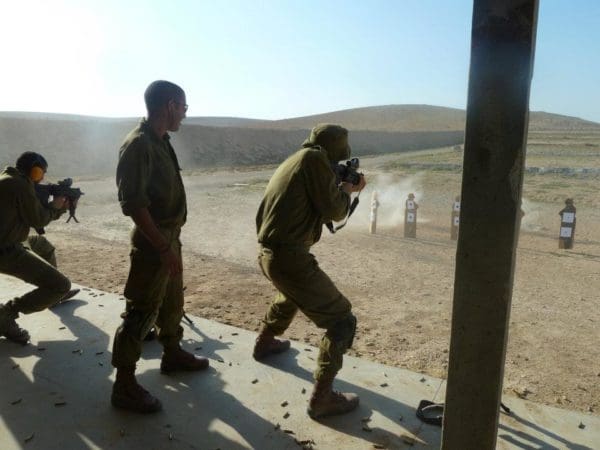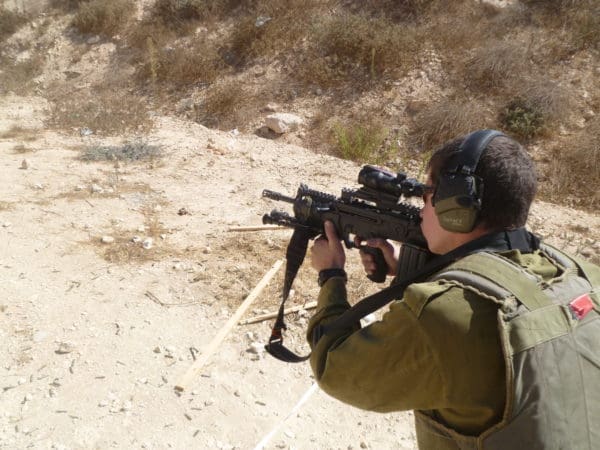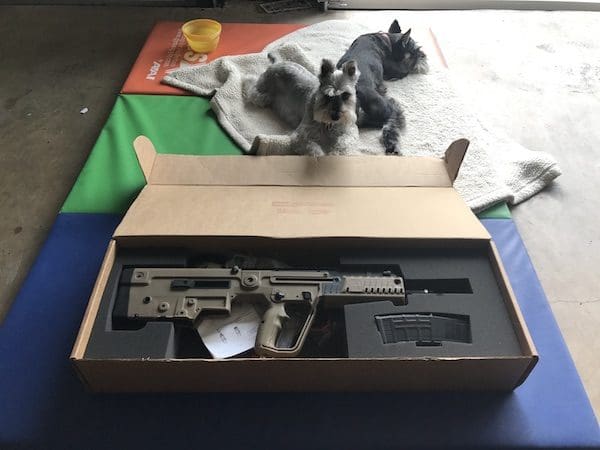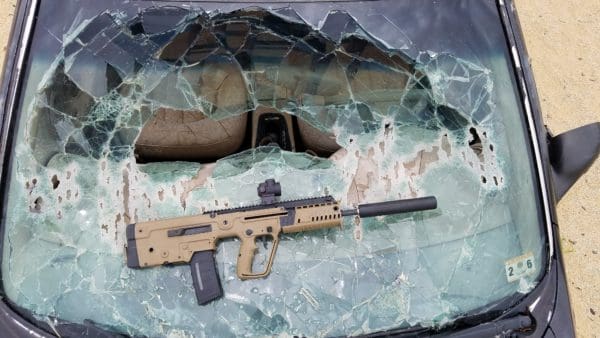
The M-16 was the first rifle I was issued during my mandatory service in the Israeli Defense Force (IDF). That’s the gun I used to become a proficient rifleman. After basic training, we switched to the more modern M-4. From then on, I carried my M-4 during my military service, and continued to carry it when I went home on leave.
All of a sudden, during deployment to the Gaza border, my unit switched over to the new Tavor X-95 rifle. With very little instruction, my life, and the lives of my unit, depended on using the IWI-made bullpup firearm.

At first, the X-95 felt too like a toy; it was small and almost entirely made of polymer parts. I soon learned that the bullpup’s operation was not that different than my beloved M-4. The magazine release and safety were in the same place. I had to adjust to the bolt stop — located behind the magazine — and the trigger felt completely different than the M-4’s mil-spec trigger.
It took some time getting used to the X-95 Tavor. However, basic training taught me that a rifleman should be able to shoot whatever weapon system he’s given — if he or she understands and knows the fundamentals of marksmanship and practices running the gun in a variety of circumstances.
For me, the X95 never seemed as accurate as the M4. Try as I might, I couldn’t get the IWI rifle to match the M-4’s groups. That said, after further training, I was hitting targets at 400m (437 yards) and even as far as 500m (547 yards) with M855 green tip ammunition.
The Tavor was primarily designed for CQB (close quarter combat). That’s the reality the IDF faces; most of our operations occurred in urban environments, tunnels or heavy growth areas. In fact, I could easily shoot the X-95 one-handed, using it almost like a pistol.
With all of the weight in the back, the Tavor is an easily rifle to maneuver. During long range patrols, the weight distribution made a huge difference. The X-95 seemed weightless compared to the M-4.

Since its adoption by the IDF, the Tavor has been tested in thousands of operations. It has taken out hundreds of terrorists. It is a great rifle — just like the M-4. But a good military is always trying to adapt to the threats that it faces. The X-95 does what it’s supposed to do, and does it well.
[TTAG’s review of the Tavor X-95 in 300 BLK is dropping next week.]





Trained with IDF in early 90s, part of 22 MEU. The Israelis simply refused to believe that we used iron sights out to 500 yards on our M16-A2s. Then we showed them and even then a few thought it was a trick.
I’ve never seriously considered buying a bullpup because if I’d like to switch shoulders if necessary, without having brass embedding itself in my face. I’m a factory worker not a spec. op. Operational Operator but I have hit moving targets at 300 yards with my Stag , model 1L with a EOTech 556.
In 5.56 the Tavor ejects brass at about a 45* angle forwards (towards the muzzle). It can be shouldered and fired left-handed without getting brass to the face. However, you will be sucking on some fumes haha. You can always just shoot it upside down 😉
+1. And shooting weak side, suppressed, with an X-95 is doable but less than pleasant.
It is possible (though hard in a combat senario) to swap internals to the left side. If you get the DT MDR, it takes a lot less, and is even more accurate then the tavor.
The MDR is more accurate? It isn’t even in production yet…
+1, sadly kids these days don’t get irons anymore iirc.
ya they do the iron on an x95 fold down into the rail, they are integrated
“That said, after further training, I was hitting targets at 40m (43 yards) and even as far as 55m (60 yards) with M855 green tip ammunition.”
Wha?
Right? Obviously I’m not the only one who caught that. That has to be a typo or miscommunication. Damn. I can make those shots semi regularly with my pistol.
thank you for catching the typo – it was 400m and 500m
60 yards? That’s…. not a lot.
That was my thought also. The only carbine class I took was a “basic” class. We were shoot out to 600yds (just to gather ballistics) with 300yds movers. The only real shooting we did within 50yds was shooting on the move, sometimes at movers.
To be fair, he never specifies what size of target.
Yeah, looking at those targets, if he means the 2″X2″ black square, and standing unslung, that’s fine shooting.
Anything larger than a matchbook and that’s ridiculous.
I agree it doesnt sound like much, but at the same time, I have horrible eyes and would have a hard time hitting anything much further than that with an unmagnified optic. I imagine with their mostly urban situations they rarely shoot further than that, but it does make you wonder about their abilities as rifleman.
I’m social security age, wear coke-bottle bifocal glasses and can barely even see an NRA pistol target at 50 yards, however that is what I shoot at (and always hit) with my iron-sighted rifles.
Bench rests and optics are for blind old men.
I’m blind and can consistently hit my barn @ two yards.
I think they lost some zeros in the editing process.
thank you for catching the typo – it was 400m and 500m
The X95 only has a 14″ barrel. The ballistics of the 5.56 with that barrel length are terrible. It’s pretty well documented that 14.5″ is the minimum acceptable length for the 5.56. However, the author’s comments about CQB combat imply that 60yds is sufficient for their purposes. Even then, 100yds is achievable with a 14″ barrel, just not ideal. It takes a 16″ barrel to burn all the powder in a 5.56. This is exactly why AAC developed the 300Blackout, which only needs 9″ to burn all its powder, yet has comparable stopping power to the 5.56 and fills a gap between a CQB gun that also has decent longer range ballistics. This fact is often lost on people bashing the .300BLK, unfairly comparing a 16″ 5.56 to a 16″ 300BLK.
60 yards is a decent shot…for a bow and arrow. But nothing to write home about.
thank you for catching the typo – it was 400m and 500m
Not sure what unit the author was in.
In the paratroopers we were issued M-4s from the get go not M16s.
We also qualified at distances much greater than 60 yards…..
Depends on your age and when you entered, right? IDF was phasing out M16s and replacing with M4s while phasing out M4s with Tavors and it all trickled down through various units over the course of many years, and some still run the M4. Correct?
That’s correct It would also depend on the unit. I entered service in 2006 and all Infantry units were issued M-4s from the start of basic training. After completion of advanced training we were reissued new(ish) M4s. Around 07 or 08 I started seeing Givati Brigade Soldiers being issued Tavors. There were always some M16s around mostly for non combatants and ironically the Armored units. I wasn’t reading clearly and misunderstood the authors term “rifleman” for infantryman. There are probably certain units who would slowly accept the other weapons platforms being phased out.
My sister is doing her service now and has made the comment she mostly sees Infantrymen with M4s. So I’m not exactly sure whats going on. The IDF isn’t known for it’s uh…”organizational” skills. lol.
I was in Givati 424th. Shaked.
I served in the 90’s right as the Tavor was coming out. Given the operating areas which the IDF operates most, the bullpup design, and maneuverability was wroth it. They can also put the longer barrel on it, and a bipod, and it works great too at longer distances.
The M-4 was all the rage, and still has a place in my heart. I remember the old M-16’s we got in basic. I swear they came straight out of the Vietnam war.
There are still Galli’s, and Uzi’s too floating around. I do agree the operation overall is very similar, accept everything is in a nice tight package. If you are stuck going door to door, or walking down tight alley ways it is more than adequate. Breakdown is stupid easy too, compared to the AR, although if you are proficient on that, the Tavor is child’s play. How many of us dropped our “pin shabbat” in the dirt, and spent way to much time digging around for it?
As many of us have said, a rifle is a tool, and you want the right tool for the job. In this case for most of the operating environments for the IDF, the Tavor is that tool.
You wuz an amphib?
Yup, actually we were eligible to get our aqua kings and jump wings. We were a spin off from paratroopers back in the day. We were kind of special that way.
thank you for catching the typo – it was 400m and 500m
Reading this: “— and the trigger felt completely different than the M-4’s mil-spec trigger” almost made me give up.
Then, all was lost after this little gem: “after further training, I was hitting targets at 40m (43 yards) and even as far as 55m (60 yards)”
What’s wrong with the trigger comment? It’s dead-on accurate IMHO.
True. The Tavor’s trigger is terrible. It feels like a Glock trigger. My kid has Nerf guns with better trigger feel.
The Tavor is tough BUT it’s American/ civilian market version is craptastic! It’s price is double the cost of decent civilian market AR-15s ( think Colt, BCM, Spikes Tactical, S&W, Aero Precision), crappy trigger and, and magazine manipulation feels “ not right”…compactness aside, we go back to the PRICE- it’s a $1,000.00 carbine that is marketed above its value
Thank you for your review Ron!
The man acknowledged the typo, give it a rest.
Guard dogs, or dogs guarding a bull pup?
Re: changing weapons. I worked for a while with a guy who did a hitch in the US Army, they made a tank crewman of him. When he got assigned to Fort Hood, the first thing said to him was “Take everything you just learned, over however long and at how much cost to the taxpayer, about the M-60, and throw it out the window. We’re giving you the brand new M-1”. It seems that the guys who already knew the M-60 inside out, etc,. didn’t want to deal with learning the new tank, so the new guys had that job.